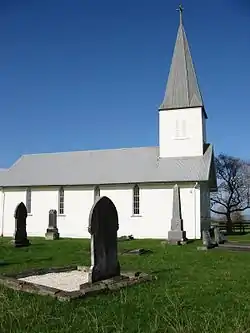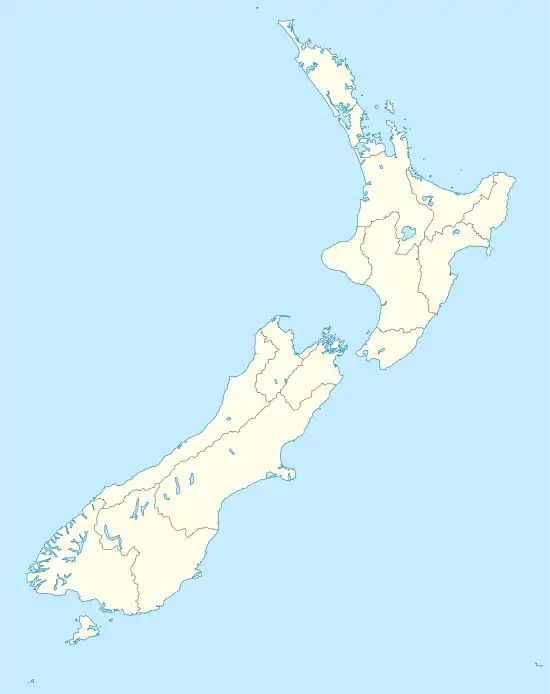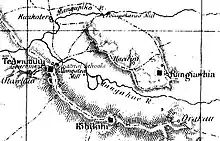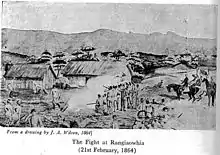Rangiaowhia
Rangiaowhia (or Rangiawhia, or Rangiaohia)[1] was, for over 20 years, a thriving village on a ridge between two streams in the Waikato region, about 4 km (2.5 mi) east of Te Awamutu. From 1841 it was the site of a very productive Māori mission station until the Invasion of the Waikato in 1864. The station served Ngati Hinetu and Ngati Apakura.[2] Only a church remains from those days, the second oldest Waikato building.
Rangiaowhia | |
|---|---|
former Village | |
 St Paul's Church (Anglican) at Rangiaowhia | |
 Rangiaowhia | |
| Coordinates: 38°00′52″S 175°22′36″E | |
| Country | New Zealand |
| Region | Waikato region |
| District | Waipa District |
| Elevation | 60 m (200 ft) |
| Population (2013 census) | |
| • Territorial | 102 |
| • Estimate (1852) | 700 |
| Time zone | UTC+12 (NZST) |
| • Summer (DST) | UTC+13 (NZDT) |
| Rangiaowhia | |
|---|---|
| Designated | 23 June 1983 |
| Reference no. | 27 |
History
In 1851 Rangiaowhia was described as, "About a thousand acres— soon greatly to be added to . . . under cultivation. . . A very numerous population of natives engaged in industry and agriculture. . . in a few years will be the granary of Auckland. . . The whole scene reminds one of English farms. Yellow cornfields bound the horizon ; orchards cluster round the houses. The mill, the flail, the plough, the spade, are seldom idle. . . the village bell calls to church or school. cultivating and rendering fruitful the wild wastes of their district,— accumulating guarantees for the continuance of peace, — in all ways setting an example to their countrymen . . . I sincerely trust that many Rangiaowhias,— such remarkable instances of the progress of the Maori race,— may soon be found throughout New Zealand."[3]
In 1852 the village was described as two miles long and with a population of about 700.[4]
An 1857 letter suggests that the area was divided between 14 hapū, who had converted their 'waste' lands to agriculture.[5]
Immediately prior to invasion in 1864, magistrate, John Eldon Gorst, wrote, "The land around Rangiaowhia and Te Awamutu, extending to and including part of Kihikihi, belongs to natives of the great Waikato tribe. . . Besides the great villages of Rangiaowhia, Kihikihi, and Kuakotari, numerous little hamlets are dotted about the country, consisting of three or four native houses surrounded by their patches of cultivated land. Even those parts of the country which appear to be only a barren waste of heavy fern land would be found, on enquiry, to have been once under cultivation, and to be now used as a pasturage for horses, cattle, or pigs . . . Rangiaowhia, for instance, is surrounded by a fence many miles in circuit; roads are made in various directions ; bridges have been thrown over impassible swamps; and a good many mill-dams have been constructed. A considerable part of the land was covered, a generation ago, with ancient forest, which the industry of the Waikatos has cleared."[6]
Churches

St Paul's Church was built in Gothic Revival style in 1852–1856 as part of the Church Missionary Society station, replacing a raupo chapel. It and the slightly earlier St John's, Te Awamutu are the oldest surviving Waikato buildings. It initially consisted of a bell tower, nave and chancel. The chancel has 2 stained glass windows, depicting St Paul's encounter with a magician.[2] They were brought from Britain by Bishop Selwyn in 1855[7] and thought to have been donated by Lady Burdett Coutts.[8] Missionary teacher, Taati Te Waru, added a steeple around 1857. The church sheltered Māori during the Imperial forces attack and was then empty until repaired in the 1870s as a parish church and school.[2] It continues to be used for services.[9]
The Catholic Holy Angels[10] mission station was about 400 metres north of St Paul's.[7] Father Jean Pezant relocated it there from Matamata in 1844.[10] In 1850 he was succeeded by Father Joseph Garavel.[11] Part of the mission station burnt down in an accidental fire[12] in 1865.[13] The church was demolished in 1931.[14] The cemetery remains, with a memorial pou erected in 2015.[10] The bishop's house was across the valley, to the east.[15]
School
Both Anglican and Catholic missions had schools. Rev. John Morgan ran an Anglican school with over 40 pupils, charging £5 a year for board and tuition in English, singing, industry and religion.[3] In May 1860 Father Garaval had 24 boys in the school when he left due to the war.[16] In 1876 the school had only one girl attending.[17]
Crops
Shortly after Rev Morgan took over Otawhao (Te Awamutu) mission station in 1841, wheat was grown there and, next year, also at Rangiaowhia. Soon Rangiaowhia wheat fields covered some 450 acres (180 ha). Other crops were barley, oats, potatoes, peach, apple, pear, plum, quince, gooseberry and almond. Cows were also milked and pigs sold in Auckland.[18] A blacksmith maintained the ploughs and other implements.[19]

Mills
In March 1846 a £200 contract (excluding carriage of timber and building the dam and leat)[18] with Stewart McMullen[20] to erect a mill was started. The mill started grinding in 1847. Its 2 ft 10 in (0.86 m) scoria millstone came from Mt Eden.[21] By 1848 Rangiaowhia flour was sold in Auckland for about £70 and, in later years, reached about £330. The 1846 mill was at Pekapekarau (or Perepekerau on another 1865 map),[15] in the valley to the west, between Hairini and Rangiaowhia.[18] A replacement mill was built between 1851[3] and 1855[22] for £400[23] on Te Rua-o-Tawhiwhi stream, to the east of Rangiaowhia.[18] Both streams feed the Mangapiko Stream, one of the Waipa's tributaries. There were also mills at most of the surrounding settlements.[24]
Governor Grey visited the mill in 1849 and was presented with 2 bags of flour for Queen Victoria.[25] He also spent half a day at Rangiaowhia in 1857,[26] In the gold rushes of 1849–52, Rangiaowhia flour was often shipped to San Francisco and Melbourne.[18]
Invasion

Pōtatau was installed as King at Rangiaowhia in 1858, after which it became a target for government control.[27] To guard against this the roads to Rangiaowhia were defended by new pas at Paterangi and Rangiatea (near Te Rahu, north of Te Awamutu). However, General Cameron, in his Invasion of the Waikato, avoided them by taking nearly 1,000 troops overnight from Te Rore via Waiari, just avoiding Paterangi to the north, and Te Awamutu. There were about 200 of Ngati-Apakura and Ngati-Hinetu at Rangiaowhia, supplying food to the garrisons at the pas.[28] At dawn on 21 February 1864 the troops attacked.[29] Most people fled, a few shot at the troops, some sheltered in the churches, 7 were burnt in their whare[30] and at least one attempted to surrender, but was murdered by troops ignoring their orders.[31] About a dozen houses were burned down. 12 Māori were killed and over 30 taken prisoner.[30] As the village was largely occupied by women, children and older men, the deaths have been regarded as murder, rather than an act of war.[32] The role of Bishop Selwyn is also unclear. He came with the invading forces,[32] but also helped with Māori burials.[33]
Later that day Paterangi, Pikopiko, and Rangiatea pas were deserted, in favour of digging a rifle-trench with a narrow opening to block the road from Te Awamutu on the crest of the ridge at Hairini. Next morning, the 22nd, the cavalry advanced on Hairini, backed by artillery and foot soldiers. 3 soldiers and about 20 Māori died, though the numbers are disputed.[32] The troops then looted the village,[30] though it has been suggested that the Hairini defence was a diversionary tactic, to allow more time to move more goods and animals south to safety.[7] However, enough was left for looting to continue for at least a month after the invasion.[34]
The 150th anniversary was commemorated in 2014 with the unveiling of a plaque.[30]
Redoubt
A 200-man redoubt was built later in February, in what is now the Hall domain,[7] formerly a school.[28] In the 1870s a blockhouse was added, manned by the Armed Constabulary.[35]
Post 1864
Within a month of the invasion, the William Fox government issued a proclamation that rebels who surrendered would get some of their land back, but those who didn't would have their land confiscated.[36] By 1868 there was concern at the resentment the takeover by military settlers was causing.[37] The church was restored in 1875.[38] Rangiaowhia riding was formed as one of 5 ridings in Waipa county in 1876,[39] with Puniu River as its southern boundary.[40] A state school near the hall ran from 1874 to 1939,[41] when several schools were amalgamated into an expanded Te Awamutu school.[42] The school house of about 1900 remains, as does the hall, built on the domain in 1907.[41]
Demographics
Rangiaowhia is in Meshblock 0987100, which had 102 people at the 2013 census, 90 in 2006 and 93 in 2001.[43]
Prominent people
Lloyd Mandeno (1888–1973), engineer and inventor
References
- "The Name Rangiaowhia | NZETC". nzetc.victoria.ac.nz. Retrieved 30 April 2017.
- "St Paul's Church (Anglican) | Heritage New Zealand". www.heritage.org.nz. Retrieved 24 April 2017.
- "A SKETCH BY A RECENT VISITOR AT RANGIAOWHIA. (Daily Southern Cross, 1851-05-13)". paperspast.natlib.govt.nz National Library of New Zealand. Retrieved 23 April 2017.
- "NOTES Of a short Tour into the Interior of the Northern Colony of New Zealand, in March and April, 1852. (Continued.) (New Zealander, 1852-06-23)". paperspast.natlib.govt.nz National Library of New Zealand. Retrieved 30 April 2017.
- "LETTER FROM RANGIAOWHIA. (Maori Messenger : Te Karere Maori, 1857-06-30)". paperspast.natlib.govt.nz National Library of New Zealand. Retrieved 29 April 2017.
- "FURTHER PAPERS RELATIVE TO THE NATIVE INSURRECTION. (Appendix to the Journals of the House of Representatives, 1864-01-01)". paperspast.natlib.govt.nz National Library of New Zealand. Retrieved 28 April 2017.
- Ritchie, Neville (2001). "The Waikato War of 1863–64 A guide to the main events and sites" (PDF). Department of Conservation.
- "HISTORIC PARISH (New Zealand Herald, 1934-06-23)". paperspast.natlib.govt.nz National Library of New Zealand. Retrieved 30 April 2017.
- "Service Times". stjohnsteawamutu.wainet.org. Retrieved 24 April 2017.
- Johnston, Grant (12 March 2015). "Magnificent memorial pou unveiled at Rangiaowhia" (PDF). Te Awamutu Courier.
- Harman, Sandy (2010). "THE STRUGGLE FOR SUCCESS: A Socio-Cultural Perspective on the French Marist Priests and their Māori Mission (1838–1867)". University of Waikato.
- "FIRE AT RANGIAOHIA. (New Zealander, 1865-04-25)". paperspast.natlib.govt.nz National Library of New Zealand. Retrieved 25 April 2017.
- "FIRE AT RANGIAWHIA. (New Zealand Herald, 1865-03-23)". paperspast.natlib.govt.nz National Library of New Zealand. Retrieved 25 April 2017.
- "OLD CHURCH DEMOLISHED. (Auckland Star, 1931-02-20)". paperspast.natlib.govt.nz National Library of New Zealand. Retrieved 25 April 2017.
- "Plan of the Military settlements in the Upper Waikato District". ap01.alma.exlibrisgroup.com. Retrieved 26 April 2020.
- "E-04 NATIVE SCHOOLS. REPORTS OF INSPECTORS. (Appendix to the Journals of the House of Representatives, 1862-01-01)". paperspast.natlib.govt.nz National Library of New Zealand. Retrieved 25 April 2017.
- "Parliamentary Papers | Appendix to the Journals of the House of Representatives | 1877 Session I | This page". paperspast.natlib.govt.nz National Library of New Zealand. Retrieved 25 April 2017.
- "Chapter III — Plough and Flour-Mill. | NZETC". nzetc.victoria.ac.nz. Retrieved 24 April 2017.
- "REPORT ON SCHOOLS ESTABLISHED BY SIR GEORGE GREY. (Daily Southern Cross, 1863-05-22)". paperspast.natlib.govt.nz National Library of New Zealand. Retrieved 24 April 2017.
- "01280 Copy of a Despatch from Governor Grey to Earl Grey (Prime Minister)". digital.liby.waikato.ac.nz. Retrieved 24 April 2017.
- "The New-Zealander. SATURDAY, JULY 3, 1847. (New Zealander, 1847-07-03)". paperspast.natlib.govt.nz National Library of New Zealand. Retrieved 25 April 2017.
- "MAORI MILLS. (Maori Messenger : Te Karere Maori, 1855-03-01)". paperspast.natlib.govt.nz National Library of New Zealand. Retrieved 24 April 2017.
- "01420 Despatch". digital.liby.waikato.ac.nz. Retrieved 24 April 2017.
- "Journal of the Polynesian Society: Maori Flour Mills Of The Auckland Province, 1846–1860, By R. P. Hargreaves, P 227-232". www.jps.auckland.ac.nz. Retrieved 24 April 2017.
- "01136 Despatch". digital.liby.waikato.ac.nz. Retrieved 25 April 2017.
- "HIS EXCELLENCY'S VISIT TO THE WAIKATO. (Wellington Independent, 1857-06-20)". paperspast.natlib.govt.nz National Library of New Zealand. Retrieved 25 April 2017.
- Zealand, National Library of New. "Papers Past | E-01b FURTHER PAPERS RELATIVE TO THE NATIVE INSURRECTION. (Appendix to the Journals of the House of Representatives, 1 January 1861)". paperspast.natlib.govt.nz. Retrieved 25 April 2017.
- Cowan, James (1955). "The New Zealand Wars: A History of the Maori Campaigns and the Pioneering Period: Volume I: 1845–1864 Chapter 37: The Invasion of Rangiaowhia". nzetc.victoria.ac.nz. Retrieved 24 April 2017.
- "ADVANCE ON RANGIAWHIA. AND ENGAGEMENT. TELEGRAM. (Daily Southern Cross, 1864-03-01)". paperspast.natlib.govt.nz National Library of New Zealand. Retrieved 25 April 2017.
- "150 years since attack on Rangiaowhia in the NZ Wars | Ministry for Culture and Heritage". www.mch.govt.nz. Retrieved 25 April 2017.
- "THE ENGAGEMENT AT RANGIAWHIA. (Daily Southern Cross, 1864-05-28)". paperspast.natlib.govt.nz National Library of New Zealand. Retrieved 25 April 2017.
- O’Malley, Vincent (December 2010). "Te Rohe Potae War and Raupatu" (PDF). Ministry of Justice – Waitangi Tribunal.
- "DEPARTURE OF BISHOP SELWYN. (Daily Southern Cross, 1868-10-21)". paperspast.natlib.govt.nz National Library of New Zealand. Retrieved 30 April 2017.
- "TE AWAMUTU. (New Zealand Herald, 1864-04-06)". paperspast.natlib.govt.nz National Library of New Zealand. Retrieved 28 April 2017.
- Prickett, Nigel (2016). "Fortifications of the New Zealand Wars" (PDF). Department of Conservation.
- "Appendix to the Journals of the House of Representatives 1864 Session". paperspast.natlib.govt.nz National Library of New Zealand. Retrieved 30 April 2017.
- "THE WAIKATO. (Daily Southern Cross, 1868-11-16)". paperspast.natlib.govt.nz National Library of New Zealand. Retrieved 30 April 2017.
- "RANGIAOHIA CHURCH RESTORATION. (Waikato Times, 1875-04-22)". paperspast.natlib.govt.nz National Library of New Zealand. Retrieved 29 April 2017.
- "COUNTIES RIDINGS. (New Zealand Herald, 1876-11-27)". paperspast.natlib.govt.nz National Library of New Zealand. Retrieved 30 April 2017.
- "Rangiaohia". nzetc.victoria.ac.nz. 1902. Retrieved 30 April 2017.
- "Waipa Heritage Trail" (PDF). Waipa District Council. 2008.
- "NEWS OF THE DAY. (Auckland Star, 1939-02-15)". paperspast.natlib.govt.nz National Library of New Zealand. Retrieved 30 April 2017.
- 2013 Census map – QuickStats about a place
